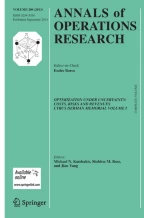Abstract
Whereas CP methods are strong with respect to the detection of local infeasibilities, OR approaches have powerful optimization abilities that ground on tight global bounds on the objective. An integration of propagation ideas from CP and Lagrangian relaxation techniques from OR combines the merits of both approaches. We introduce a general way of how linear optimization constraints can strengthen their propagation abilities via Lagrangian relaxation. The method is evaluated on a set of benchmark problems stemming from a multimedia application. The experiments show the superiority of the combined method compared with a pure OR approach and an algorithm based on two independent optimization constraints.
Similar content being viewed by others
References
R.K. Ahuja, T.L. Magnanti and J.B. Orlin, Network Flows (Prentice-Hall, Englewood Cliffs, NJ, 1993).
E. Balas and E. Zemel, An algorithm for large-scale zero–one knapsack problems, Operations Research 28 (1980) 119–148.
J. Desrosiers, Y. Dumas, M.M. Solomon and F. Soumis, Time constrained routing and scheduling, in: Network Routing, Handbooks in Operations Research and Management Science, eds. M.O. Ball, T. Magnanti, C. Monma and G. Nemhauser, Vol. 8 (North-Holland, Amsterdam, 1995) pp. 35–139.
J. Desrochers and F. Soumis, A generalized permanent labeling algorithm for the shortest path problem with time windows, INFORS 26(3) (1988) 191–211.
H. Everett, Generalized Lagrange multiplier method for solving problems of optimum allocation of resource, Operations Research 11 (1963) 399–417.
T. Fahle, U. Junker, S.E. Karisch, N. Kohl, M. Sellmann and B. Vaaben, Constraint programming based column generation for crew assignment, Journal of Heuristics 8(1) (2002) 59–81.
T. Fahle and M. Sellmann, Constraint programming based column generation with knapsack subproblems, Annals of Operations Research 115 (2002) 73–94.
F. Focacci, A. Lodi and M. Milano, Cutting planes in constraint programming: An hybrid approach, in: Proc. of CP'00, Lecture Notes in Computer Science, Vol. 1894 (Springer, Berlin, 2000) pp. 187–201.
M.C. Golumbic, Algorithmic Graph Theory and Perfect Graphs (Academic Press, New York, 1991).
M. Held and R.M. Karp, The traveling-salesman problem and minimum spanning trees, Operations Research 18 (1970) 1138–1162.
M. Held and R.M. Karp, The traveling-salesman problem and minimum spanning trees: Part II, Mathematical Programming 1 (1971) 6–25.
J.Y. Hsiao, C.Y. Tang and R.S. Chang, An efficient algorithm for finding a maximum weight 2-independent set on interval graphs, Information Processing Letters 43(5) (1992) 229–235.
ILOG, Ilog Solver, Reference manual and user manual, V5.0 (ILOG, 2000).
U. Junker, S.E. Karisch, N. Kohl, B. Vaaben, T. Fahle and M. Sellmann, A framework for constraint programming based column generation, in: Proc. of the CP'99, Lecture Notes in Computer Science, Vol. 1713 (Springer, Berlin, 1999) pp. 261–274.
M. Lehradt, Basisalgorithmen für ein TV Anytime System, Diploma Thesis, University of Paderborn (2000).
S. Martello and P. Toth, An upper bound for the zero–one knapsack problem and a branch and bound algorithm, European Journal of Operational Research 1 (1977) 169–175.
mediaTV, Technical Description, Axcent AG, http://www.axcent.de.
M. Milano, Integration of mathematical programming and constraint programming for combinatorial optimization problems, in: Proc. of CP2000, Singapore (September 2000) tutorial.
G.L. Nemhauser and L.A.Wolsey, Integer and Combinatorial Optimization (Wiley, New York, 1988).
M. Sellmann and T. Fahle, Coupling variable fixing algorithms for the Automatic Recording Problem, in: 9th Annual European Symposium on Algorithms (ESA 2001), Lectures Notes in Computer Science, Vol. 2161 (2001) pp. 134–145.
Author information
Authors and Affiliations
Rights and permissions
About this article
Cite this article
Sellmann, M., Fahle, T. Constraint Programming Based Lagrangian Relaxation for the Automatic Recording Problem. Annals of Operations Research 118, 17–33 (2003). https://doi.org/10.1023/A:1021845304798
Issue Date:
DOI: https://doi.org/10.1023/A:1021845304798
